
Biomechanics Principles and Applications - Schneck and Bronzino
.pdf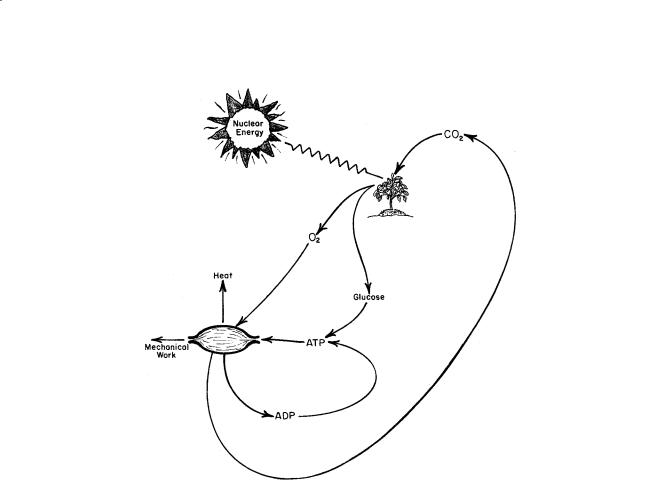
152 |
Biomechanics: Principles and Applications |
FIGURE 10.1 Schematic of energy transformations leading to muscular mechanical work.
∑F = 0 |
|
(10.1) |
|
∑T = 0 |
|
(10.2) |
|
where F = vectorial forces (N) and T = vectorial torques (N·m). |
TABLE 10.1 Fraction of Body Weights |
||
Some sport activities, such as wrestling, weightlifting, and |
for Various Parts of the Body |
|
|
fencing, require stability, whereas other activities, including run- |
|
|
|
Body Part |
Fraction |
||
ning, jumping, and diving, cannot be performed unless there is |
|||
|
|
||
Head and neck |
0.07 |
||
managed instability. Shifting body position allows the proper |
|||
control. The mass of the body is distributed as in Table 10.1, and |
Trunk |
0.43 |
|
Upper Arms |
0.07 |
||
the center of mass is located at approximately 56% of a person’s |
|||
Forearms and hands |
0.06 |
||
height and midway from side-to-side and front-to-back. The |
|||
Thighs |
0.23 |
||
center of mass can be made to shift by extending the limbs or |
Lower legs and feet |
0.14 |
|
by bending the torso. |
|
1.00 |
|
|
|
|
|
Muscular Movement
Mechanical movement results from contraction of muscles that are attached at each end to bones that can move relative to each other. The arrangement of this combination is commonly known as a class 3 lever (Fig. 10.2), where one joint acts as the fulcrum (Fig. 10.3), the other bone acts as the load, and the
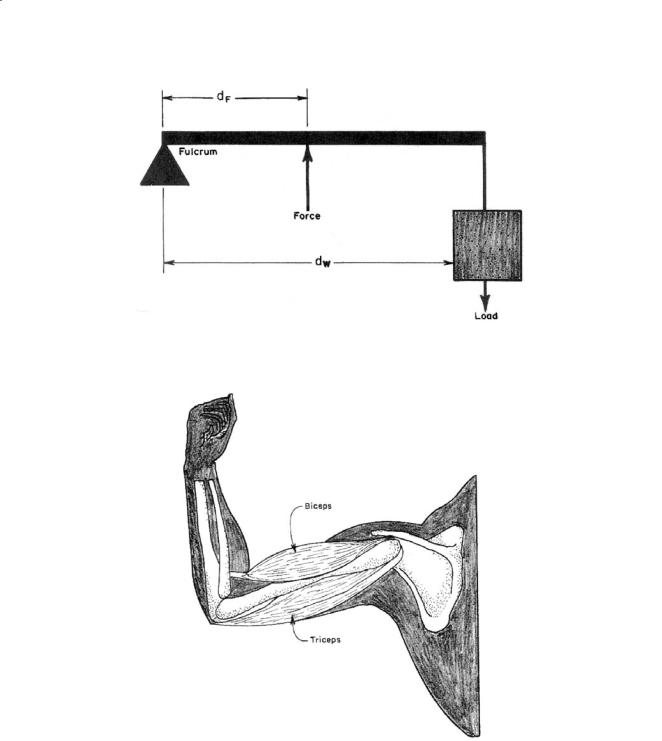
Factors Affecting Mechanical Work in Humans |
153 |
FIGURE 10.2 A class 3 lever is arranged with the applied force interposed between the fulcrum and the load. Most skeletal muscles are arranged in this fashion.
FIGURE 10.3 The biceps muscle of the arm is arranged as a class 3 lever. The load is located at the hand and the fulcrum at the elbow.
muscle provides the force interposed between fulcrum and load. This arrangement requires that the muscle force be greater than the load, sometimes by a very large amount, but the distance through which the muscle moves is made very small. These characteristics match muscle capabilities well (muscles can produce 7 × 105 N/m2, but cannot move far). Since the distance is made smaller, the speed of shortening of the contracting muscle is also slower than it would be if the arrangement between the force and the load were different:
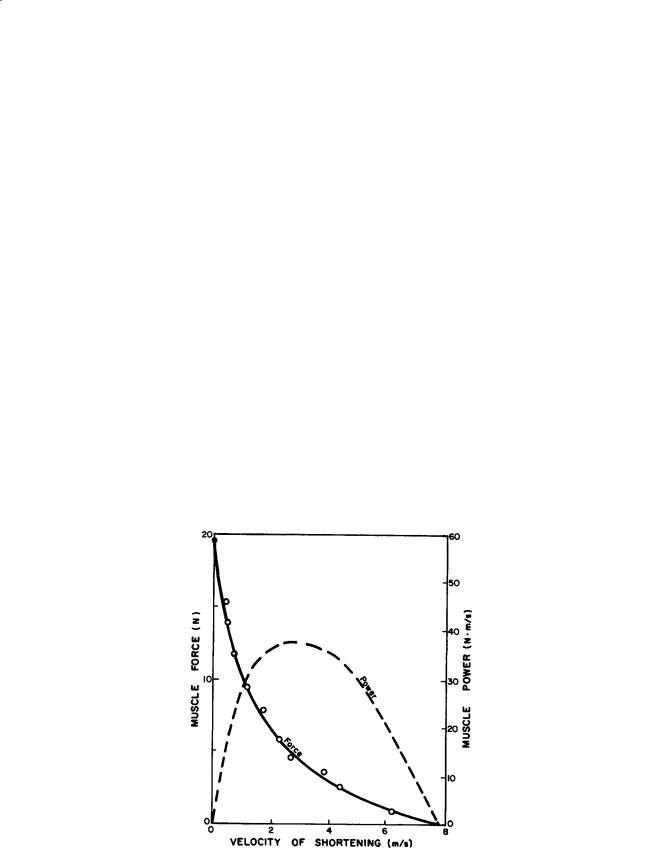
154 Biomechanics: Principles and Applications
|
|
SL |
= |
dL |
(10.3) |
|
|
SM |
dM |
||
|
|
|
|
||
where S |
= speed, m/s |
|
|
|
|
d |
= distance from fulcrum, m |
|
|
|
|
L, M = denote load and muscle
Muscular Efficiency
Efficiency relates external, or physical, work produced to the total chemical energy consumed:
η = |
External work produced |
(10.4) |
|
Chemical energy consumed |
|||
|
|
Muscular efficiencies range from close to zero to about 20–25%. The larger numbers would be obtained for leg exercises that involve lifting body weight. In carpentry and foundry work, where both arms and legs are used, average mechanical efficiency is approximately 10% [Johnson, 1991]. For finer movements that require exquisite control, small muscles are often arranged in antagonistic fashion; that is, the final movement is produced as a result of the difference between two or more muscles working against each other. In this case, efficiencies approach zero. Isometric muscular contraction, where a force is produced but no movement results, has an efficiency of zero.
Muscles generally are able to exert the greatest force when the velocity of muscle contraction is zero. Power produced by this muscle would be zero. When the velocity of muscle contraction is about 8 m/s, the force produced by the muscle becomes zero, and the power produced by this muscle again becomes zero. Somewhere between, the power produced, and the efficiency, becomes a maximum (Fig. 10.4).
FIGURE 10.4 Force and power output of a muscle as a function of velocity. (Adapted and used with permission from Milsum [1966].)
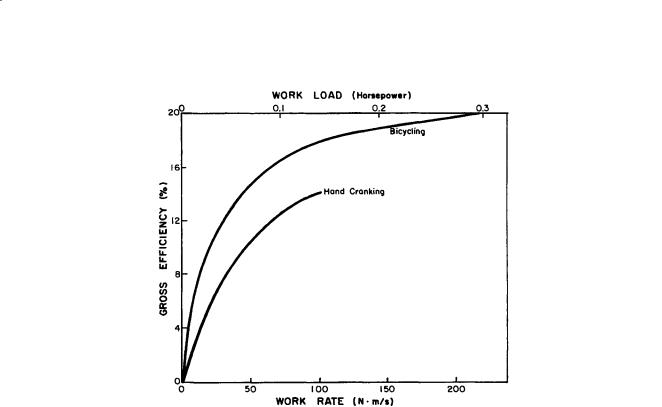
Factors Affecting Mechanical Work in Humans |
155 |
FIGURE 10.5 The gross efficiency for hand cranking or bicycling as a function of the rate of work [Goldman, 1978].
The isometric length-tension relationship of a muscle shows that the maximum force developed by a muscle is exerted at its resting length (the length of a slightly stretched muscle attached by its tendons to the skeleton) and decreases to zero at twice its resting length. Maximum force also decreases to zero at the shortest possible muscular length. Since muscular contractile force depends on the length of the muscle and length changes during contraction, muscular efficiency is always changing (Fig. 10.5).
Negative (eccentric) work is produced by a muscle when it maintains a force against an external force tending to stretch the muscle. An example of negative work is found as the action of the leg muscle during a descent of a flight of stairs. Since the body is being lowered, external work is less than zero. The muscles are using physiological energy to control the descent and prevent the body from accumulating kinetic energy as it descends.
Muscular efficiencies for walking downhill approach 120% [McMahon, 1984]. Since heat produced by the muscle is the difference between 100% and the percent efficiency, heat produced by muscles walking downhill is about 220% of their energy expenditure. Energy expenditure of muscles undergoing negative work is about one-sixth that of a muscle doing positive work [Johnson, 1991], so a leg muscle going uphill produces about twice as much heat as a leg muscle going downhill.
Locomotion
The act of locomotion involves both positive and negative work. There are four successive stages of a walking stride. In the first stage, both feet are on the ground, with one foot ahead of the other. The trailing foot pushes forward, and the front foot is pushing backward. In the second stage the trailing foot leaves the ground and the front foot applies a braking force. The center of mass of the body begins to lift over the front foot. In the third stage the trailing foot is brought forward, and the supporting foot applies a vertical force. The body center of mass is at its highest point above the supporting foot. In the last stage, the body’s center of mass is lowered, and the trailing foot provides an acceleration force.
This alteration of the raising and lowering of the body center of mass, along with the pushing and braking provided by the feet, makes walking a low-efficiency maneuver. Walking has been likened to alternately applying the brakes and accelerator while driving a car. Just as the fuel efficiency of the car
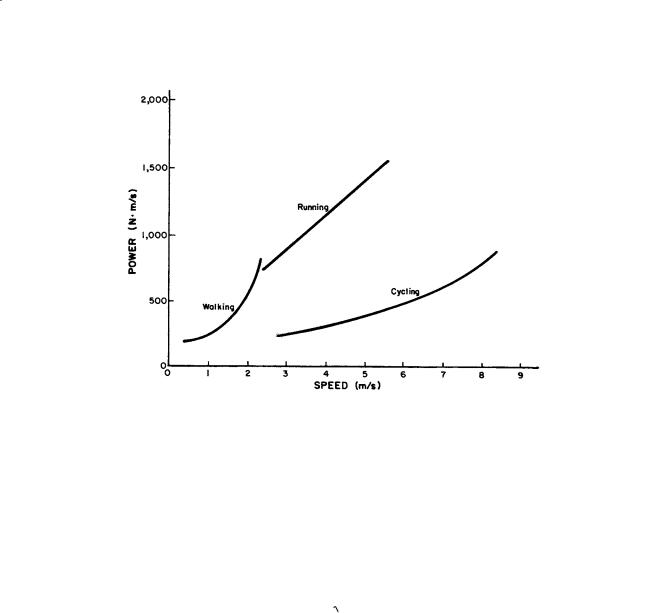
156 |
Biomechanics: Principles and Applications |
FIGURE 10.6 Power required for walking, running, and cycling by an adult male. Curves for walking and running intersect at about 2.3 m/s and show that walking is more efficient below the intersection and running is more efficient above. (Redrawn with permission from Alexander [1984].)
would suffer from this mode of propulsion, so the energy efficiency of walking suffers from the way walking is performed.
There is an optimum speed of walking. Faster than this speed, additional muscular energy is required to propel the body forward. Moving slower than the optimal speed requires additional muscular energy to retard leg movement. Thus, the optimal speed is related to the rate at which the leg can swing forward. Simple analysis of the leg as a physical pendulum shows that the optimal walking speed is related to leg length:
S L |
(10.5) |
Unlike walking, there is a stage of running during which both feet leave the ground. The center of mass of the body does not rise and fall as much during running as during walking, so the efficiency for running can be greater than for walking.
At a speed of about 2.5 m/s, running appears to be more energy efficient than walking, and the transition is usually made between these forms of locomotion (Fig. 10.6). Unlike walking, there does not appear to be a functional relationship between speed and leg length, so running power expenditure is linearly related to speed alone.
Why would anyone want to propel the extra weight of a bicycle in addition to body weight? On the surface it would appear that cycling would cost more energy than running or walking. However, the center of mass of the body does not move vertically as long as the cyclist sits on the seat. Without the positive and negative work associated with walking or running, cycling is a much more efficient form of locomotion than the other two (Fig. 10.6), and the cost of moving the additional weight of the bicycle can easily be supplied.
Many sports or leisure activities have a biomechanical basis. Understanding of the underlying biomechanical processes can lead to improved performance. Yet, there are limits to performance that cause frustrations for competitive athletes. Hence, additional factors are sometimes employed to expand these limits. Following is a brief discussion of some of these factors.

Factors Affecting Mechanical Work in Humans |
157 |
10.2 Exercise Training
Many compensatory reactions allow the body to adapt to minor stresses, such as mild exercise, so that homeostasis (equilibrium) can be maintained. For example, the increased energy demands of exercise stimulate an increase in heart rate, respiration, blood flow, and many other reactions that allow the body to maintain homeostasis. As the intensity of exercise increases, it becomes more difficult for compensatory mechanisms to maintain homeostasis. After exceeding about 80% of an untrained person’s maximal capacity, homeostasis can no longer be maintained for more than a few minutes before exhaustion results.
Regular exercise (training) elevates the level that a single exercise session can be performed before disturbing homeostasis. It does this by elevating the maximal physiological capacity for homeostasis so that the same amount of exercise may no longer disrupt homeostasis because it is a lower percentage of maximal capacity. In addition, training produces specific adaptations during submaximal exercise that permit greater and longer amounts of work before losing homeostasis. A good example of this is when
blood lactate rises with increased intensity of exercise. Prior to training, blood lactate concentration rises
•
substantially when the intensity of exercise exceeds about 75% of maximal oxygen consumption (VO2max).
Following training, the same intensity of exercise results in a lower concentration of blood lactate, so
•
exercise can now be performed at a higher fraction of VO2max before blood lactate reaches the same level as before training [Hurley et al., 1984a]. Thus, exercise training allows an individual to perform a much greater amount of work before homeostasis is disturbed to the point at which muscular exhaustion results.
10.3 Age
It is well established that the maximal capacity to exercise declines with age. However, many factors that change with age also affect an individual’s maximal capacity to exercise. These include a gain in body fat, a decrease in lean body mass, onset of disease, and a decline in the level of physical activity. For this reason
it is difficult to determine exactly how much of the loss in capacity to exercise with age can really be
•
attributed solely to the effects of aging. VO2max starts to decline after the age of 25 to 30 years at about the rate of 10% per decade in healthy sedentary women and men. This rate of decline is only half as great (~5%) when people maintain their physical activity levels as they age. Thus, there is no doubt that maximal work capacity declines with advancing age, but regular exercise appears to reduce this decline substantially.
10.4 Gender
Cardiovascular fitness and muscular strength are substantially higher in men compared to women. The aerobic capacity in men is about 40 to 50% higher than women. In addition, upper body strength is approximately 100% higher and lower body strength is about 50% higher in men [Lynch et al., 1999]. However, these differences are diminished substantially when body composition is taken into consideration. For example, when aerobic capacity is expressed with reference to body mass (ml O2/kg/min) this difference decreases to about 20% and to about 10% when differences in muscle mass are taken into consideration [Lynch et al., 1999]. Similar declines in the differences in muscular strength can be demonstrated when taking lean body mass differences into consideration. There do not appear to be any differences in responsiveness to training when expressed on a relative basis (% change), but recent evidence suggests that men have greater muscle mass gains than women when expressed in absolute terms [Tracey et al., 1999].
10.5 Ergogenic Aids
Anabolic Steroids
Anabolic steroids are drugs that function similar to the male sex hormone testosterone. Upon binding with specific receptor sites, these drugs contribute greatly to male secondary sex characteristics. These drugs have been used frequently by a large number of competitive athletes, particularly those involved
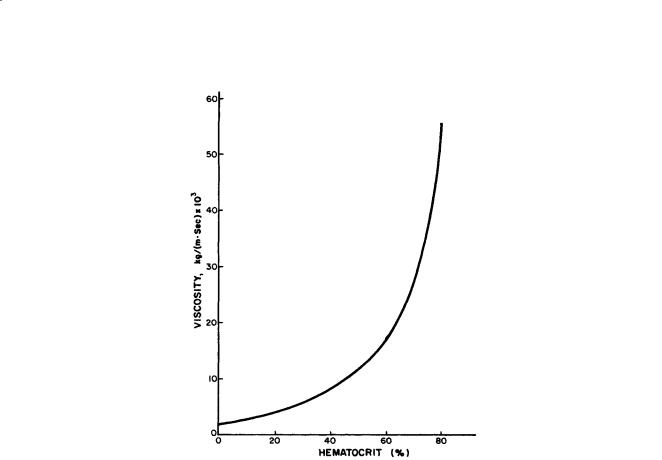
158 |
Biomechanics: Principles and Applications |
FIGURE 10.7 Blood viscosity related to blood hematocrit.
in strength and power sports. Increases in muscular strength, total body mass, and lean body mass have been reported [Bhasin et al., 1996]. It has been argued, however, that at least some of the increase in total body mass resulting from anabolic steroid use results from an increase in water retention [Casner et al., 1971]. Evidence indicates that many of these drugs act by decreasing muscle protein degradation rather than by enhancing protein synthesis [Hickson et al., 1990]. Hence, these drugs might be more appropriately named “anticatabolic” steroids. There is also some indication that these drugs work by increasing aggressive behavior and thereby promote a greater quantity and quality of training.
The factors that are responsible for transporting oxygen from the heart to skeletal muscle are enhanced following anabolic steroid administration through increases in blood volume, red blood cells (RBC), and hemoglobin. This would appear to improve cardiovascular fitness by increasing oxygen transport capacity. However, most studies show that anabolic steroids do not significantly increase cardiovascular fitness [Johnson et al., 1975]. This may be due to the increased blood viscosity resulting from the hemoconcentration effects of increasing RBCs and hemoglobin. Increases in blood viscosity may reduce blood flow to and from the heart and cause the heart to work harder in order to maintain cardiac output (Fig. 10.7).
It is clear that the use of anabolic steroids produces adverse effects on the liver and reproductive and cardiovascular systems. Effects on the liver include peliosis hepatitis (blood-filled cysts), impaired excretory function (jaundice), and liver tumors [ACSM, 1984]. Cardiovascular effects include an increase in blood pressure, abnormal alterations in cardiac tissue, and abnormal lipoprotein-lipid profiles [Hurley et al., 1984b]. Males can experience a significant reduction in sperm production, testicular size, and testosterone and gonadotrophin production, and females often experience a deepening of voice, male pattern baldness, enlargement of the clitoris, a reduction in breast size, a disruption in their menstrual cycle, and an increase in facial hair. Most of these effects are irreversible even after the drugs are discontinued. There are also many psychological effects including an increase in aggressive behavior, an increase in anger and hostility, large deviations in mood, and sudden changes in libido.

Factors Affecting Mechanical Work in Humans |
159 |
Growth Hormone
Human growth hormone, also known as somatotropic hormone, is secreted from the pituitary gland and is involved in many anabolic processes in the body including normal growth and tissue synthesis. Athletes have become more interested in the use of growth hormone (GH) in recent years because of the many reports touting its benefits, the increased awareness of the dangers of anabolic steroids, and the reduced price due to the increased availability of synthetic forms. The appeal to athletes is that GH stimulates amino acid uptake and protein synthesis in skeletal muscle and a degradation of fat in adipose tissue. It has been shown to increase fat-free mass and reduce body fat independent of diet and exercise. Nevertheless, these benefits do not come without side effects, including acromegaly (enlargement of bony structures in the extremities) and impaired glucose tolerance.
Blood Doping
This procedure is also called red blood cell (RBC) reinfusion, induced erythrocythemia, or blood boosting.
It involves withdrawing between 1 and 4 units (1 unit = 450 ml of blood) of a person’s blood and then separating the plasma (liquid portion) from the RBCs. The plasma portion is immediately reinfused, and the packed RBCs are frozen. Each unit of blood is withdrawn over a 3- to 8-week period to prevent sudden reduction in hematocrit (RBC concentration). The RBCs are then reinfused 1 to 7 days prior to an endurance event. This results in a 10 to 20% increase in RBC and hemoglobin levels as well as an
increase in total blood volume. It is believed that blood doping enhances oxygen transport to the working
•
muscles, and, since oxygen transport is considered a limiting factor for increasing VO2max , this adaptation would appear to enhance cardiovascular endurance performance. Whether blood doping actually improves endurance performance depends on the balance between enhanced oxygen transport and increased viscosity of blood. The method of storing blood appears to be an important factor in deter-
mining the potential effects of blood doping on performance. When the proper procedures have been
•
used it can increase VO2max by 5 to 13% and reduce submaximal heart rate and blood lactate during a standard exercise test [Sawka et al., 1996].
Oxygen Inhalation
Inhaling high concentrations of oxygen gas mixtures prior to athletic competition or during rest periods of sporting events are common observations. This practice is based on the notion that it will increase oxygen transport (more oxygen binding to hemoglobin), thereby increasing oxygen delivery to the working muscle and resulting in a delay in the onset of fatigue [McArdle et al., 1996]. There are at least three problems with this belief. First, hemoglobin is already almost totally saturated with oxygen during normal breathing of ambient air at rest (95 to 98%). Hence, even if this practice allowed total oxygen saturation of hemoglobin it would only add a small amount of oxygen to the arterial blood leaving the lungs (10 ml of extra oxygen for every liter of whole blood). Second, for this practice to result in a delay of fatigue one must assume that oxygen transport and delivery are limiting factors for the specific event or sport being performed. This assumption cannot be made for many of the power-type events in which oxygen inhalation is often used (e.g., football). Third, any enhancement of oxygen transport from this procedure is short-lived. Yet athletes are often observed inhaling oxygen on the sidelines for relatively long periods prior to participation. Thus, this practice does not appear to offer much more than psychological benefits when used prior to athletic competition or during prolonged rest periods.
However, breathing oxygen during prolonged steady-rate exercise results in reduced heart rates, ventilation, and blood lactate levels. Apparently even small increases in oxygen saturation of hemoglobin and some added oxygen dissolved in plasma not bound to hemoglobin results in a substantial increase in oxygen availability under conditions that approach hypoxia. It may also increase oxygen diffusion capacity across muscle capillaries by elevating the partial pressure of oxygen in the blood. Nevertheless, the timing required for oxygen inhalation to be effective makes this procedure impractical to use for most athletic events, even if it were considered ethical and legal.

160 Biomechanics: Principles and Applications
Defining Terms
Anabolic steroids: Synthetic forms of sex hormones (androgens) that possess both synthesizing and masculinizing characteristics.
Biceps muscle: The major muscle group in the upper arm responsible for flexion, joined by tendons at the shoulder and elbow. Two collaborating muscles are involved in the biceps.
Endergonic: An energy-absorbing process.
Ergogenic aids: Factors that affect human performance. Exergonic: An energy-liberating process.
Hematocrit: The concentration of red blood cells. Homeostasis: The tendency to maintain equilibrium.
Negative work: Work where the applied force and the direction of movement are opposite.
Positive work involves an applied force in the same direction as the movement. Negative work is known as eccentric work, and positive work is known as concentric by biomechanists.
References
ASCM. 1984. The use of anabolic-androgenic steroids in sports. Sports Med Bull 19:13. Alexander RM. 1984. Walking and running. Amer Sci. 72:348.
Bhasin S, Storer TW, Berman N, Callegari C, Clevenger B, Phillips J, Bunnell TJ, Tricker R, Shirazi A, and Casaburi R. 1996. The effects of supraphysiologic doses of testosterone on muscle size and strength in normal men. N Eng J Med 335:1–7.
Casner SW, Early RG, Carlson BR. 1971. Anabolic steroid effects on body composition in normal young men. J Sports Med Phys Fitness 11:98.
Goldman RF. 1978. Computer models in manual materials handling. In CG Drury (Ed.), Safety in Manual Materials Handling, pp. 110–116, Cincinnati, OH, National Institute for Occupational Safety and Health (NIOSH).
Hickson RC, Czerwinski SM, Falduto MT et al. 1990. Glucocorticoid antagonism by exercise and andro- genic-anabolic steroids. Med Sci Sports Exerc 22:331.
Hurley BF, Hagberg JM, Allen WK et al. 1984a. Effect of training on blood lactate levels during submaximal exercise. J Appl Physiol 56:1260.
Hurley BF, Seals DR, Hagberg JM et al. 1984b. High-density-lipoprotein cholesterol in bodybuilders v powerlifters. JAMA 252:507.
Johnson AT. 1991. Biomechanics and Exercise Physiology, New York, John Wiley & Sons.
Johnson LC, Roundy ES, Allsen PE et al. 1975. Effect of anabolic steroid treatment on endurance. Med Sci Sports Exerc 7:287.
Lynch NA, Metter EJ, Lindle RS, Fozard JL, Tobin JD, Roy TA, Fleg JL, Hurley BF. 1999. Muscle quality. I. Age-associated differences between arm and leg muscle groups. J Appl Physiol 86:188.
McArdle WD, Katch FI, and Katch VL. 1996. Special aids to performance and conditioning. In Exercise Physiology: Energy, Nutrition, and Human Performance, pp. 469–470. Baltimore, MD, Williams & Wilkins.
McArdle WD, Katch FI, Katch VL. 1994. Training muscles to become stronger. In Essentials of Exercise Physiology, pp. 373–397, Baltimore, MD, Lea & Febiger.
McMahon TA. 1984. Muscles, Reflexes, and Locomotion, Princeton, NJ, Princeton University Press. Milsum JH. 1966. Biological Control Systems Analysis, New York, McGraw-Hill.
Sawka MN, Joyner MJ, Miles DS, Robertson RJ, Spriets LL, Young AJ. 1996. The use of blood doping as an ergogenic aid. Med Sci Sports Exerc 28:i–viii.
Shapiro P, Ikedo RM, Ruebner BH, et al. 1977. Multiple hepatic tumors and peliosis hepatitis in Fanconi’s anemia treated with androgens. Am J Dis Child 131:1104.
Tracy BL, Ivey FM, Hurlbut D, Martel GF, Lemmer JT, Siegel EL, Metter EJ, Fozard JL, Fleg JL, Hurley BF. 1999. Muscle quality. II. Effects of strength training in 65to 75-year-old men and women. J Appl Physiol 86:195.

Factors Affecting Mechanical Work in Humans |
161 |
Further Information
A comprehensive treatment of quantitative predictions in exercise physiology and biomechanics is presented in Biomechanics and Exercise Physiology by A. T. Johnson (John Wiley & Sons, 1991). There are a number of errors in the book, but an errata sheet is available from the author.
Clear and simple explanations of the biomechanics of sports are given in Physics in Biology and Medicine by P. Davidovits (Prentice-Hall, 1975).
The book by Tom McMahon, Muscles, Reflexes, and Locomotion (Princeton University Press, 1984), is a classic not to be missed.
The article by McArdle and colleagues in Essentials of Exercise Physiology (Williams & Wilkens, 1996) is an excellent source for a better understanding of physiological principles of work performance.
See D. A. Winter’s Biomechanics and Motor Control of Human Movement (John Wiley & Sons, 1990) for a good in-depth explanation of more traditional biomechanics.
